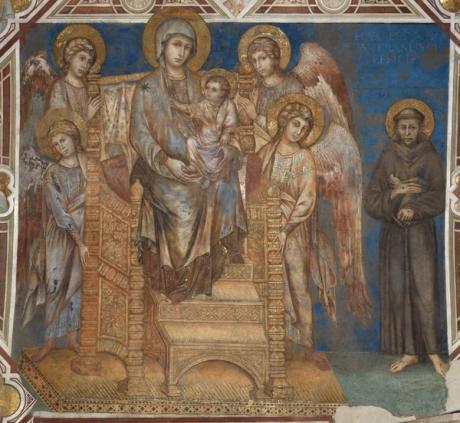
A fading fresco by the 13th-century artist Cimabue that survived a deadly earthquake 25 years ago has been returned to its original splendour following a €300,000 restoration funded by the luxury car manufacturer Ferrari. Located in the right transept of the Lower Church of the Basilica of San Francesco di Assisi, a lavishly decorated pilgrimage site in the Umbrian town of Assisi, the newly restored work will be officially inaugurated on 16 February following a year-long restoration.Cimabue’s Madonna Enthroned with the Child, Four Angels and St Francis (around 1285-88)—also known as the Maestà di Assisi—depicts the Virgin Mary with child on a throne surrounded by four winged angels and flanked by St. Francis of Assisi, in what is believed to be one of the earliest depictions of the mystic and friar who founded the religious order of the Franciscans. Repainted in the late 16th century, the fresco was previously restored twice: between 1872 and 1874, and in 1973. It survived an earthquake in 1997 that caused the roof of the adjoining Upper Church to collapse, killing four.The project marks the first time Ferrari has funded an art restoration, Italy’s state broadcaster Rai reports. “[Italy] is an exceptional country, famous for its artistic heritage stretching back thousands of years,” Benedetto Vigna, the chief executive of the car manufacturer, said in a statement in December 2022, when the project was announced. “For Ferrari, which belongs to a world of luxury that is ever closer to that of art and culture, it is important to make a contribution to the preservation of a masterpiece.”The fresco’s once vibrant colouring had been tarnished by dirt deposited by the millions of annual visitors to the basilica, Sergio Fusetti, the basilica’s chief restorer, tells The Art Newspaper. Moreover, the form of some details—including San Francesco’s beard and ears, and the Madonna and child’s face—had been modified by restorers in the 19th century. In the 1970s, restorers applied a protective coating called Polaroid B72 that made the surface appear reflective and yellowish under modern lighting. Prior to the new restoration, Fusetti and a team from Tecnireco, a Spoleto-based cultural heritage restoration company, used x-ray fluorescence and infrared spectroscopy to identify which parts of the fresco were original and which had been added later. The analysis also allowed them to determine which pigments Cimabue had used. Experts then cleaned the fresco by removing dirt and the protective layer applied in the 1970s. To avoid painting over the original fresco, they replaced pigment that had become detached, especially azurite pigment used for the background, with neutral colours such as grey. “We have taken away all of the additions made over the centuries,” says Fusetti, adding that the painting had now regained its original luminosity. “What we now see is the original work.”Since the 1997 earthquake, personnel from Tecnireco have been entrusted with cleaning all of the frescoes, which cover a surface area of 10,000 sq. m, once a year. Annual dusting will help keep Maestà di Assisi in good condition, Fusetti says. “We won’t need to restore it for another 60 or 70—maybe even 100—years,” he adds. “Future maintenance will be more affordable as a result.’


























